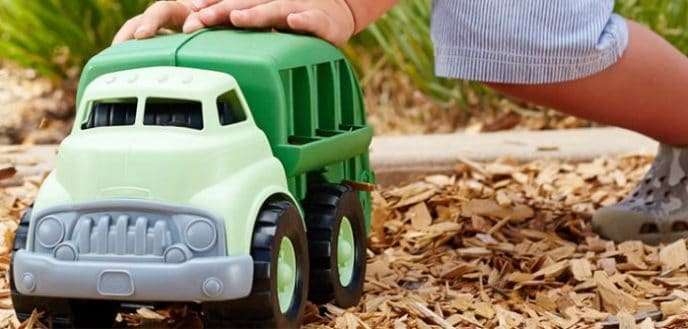Most toys are made from plastic. And the bad news is they are having a major impact on our health, our children’s health, and the planet’s health, too. Here’s why it’s time the entire industry turned its back on plastic for good.
Throughout its nearly two-hour run time, the new Barbie movie makes several self-aware jabs. The thought-provoking storyline takes into account the doll’s impact on beauty standards and body image, for example, as well as the profit-driven motives of her toy giant manufacturer, Mattel (also a co-producer of the movie). But there was, arguably, one important self-aware thread that was missing. Barbie World thrives on plastic.
While Mattel has launched a handful of Barbie dolls made with recycled materials, most are made with virgin fossil fuel-based synthetics, including polyvinyl chloride, ethylene vinyl acetate, and hard vinyl — plastic, plastic, and more plastic. And it isn’t just Mattel’s Barbie dolls that are made with these types of materials; the global toys market, which was valued at more than $170 billion in 2022, is built almost entirely on plastic.
Why plastic is hurting the planet
Mattel is far from alone. The toy market is the most plastic-intensive industry in the world. In fact, right now, it’s predicted that 90 percent of all toys are made from plastic. Take Lego, for example. The Danish company is responsible for producing around 100,000 tons of plastic every year worldwide.
When children grow up and discard these toys, some will be resold or handed down, but many will get thrown in the trash. According to Yale University, around 80 percent of toys will eventually end up in the trash.
But, of course, plastics do not break down in the environment, instead, they turn into microplastics that litter the world’s green spaces and oceans, or spend years leaching microplastics into the earth in landfills.
These tiny fragments of plastic may alter entire ecosystems due to the toxic, harmful impact they can have on wildlife.

For example, researchers have observed fish acting erratically because they have ingested microplastics, causing them to actively end up in dangerous situations.
“Their gut is saying ‘you’re full’, but their brain is saying ‘you need nutrition,’” said Prof Mark McCormick of James Cook University to the Guardian.
“Like humans, when we’re very hungry, we might run across the road … as opposed to walking across safely,” he continued. “And for the fish who are hungry, they are more willing to take risks, and this means straying further from shelter for food, where they are eaten by predators.”
And that’s just one example. Microplastics are also associated with delayed growth, oxidative damage, and reduced food intake in marine life.
Does plastic harm our health, too?
It’s not just animals and the environment that are suffering from our overreliance on plastic. These chemicals can also impact our bodies, too. And because of their love for toys (which often make their way into their mouths, too), children are particularly at risk.
“When you’re a kid crafting another space mission for Astronaut Barbie or designing a wedding for Chef Barbie that includes a 200+ plushie guest list, plastic toxicity is the last thing on your mind,” notes the Plastic Pollution Coalition, a non-profit organization dedicated to reducing plastic waste. “The reality is that plastic toys, including Barbies, are made out of fossil fuels and a cocktail of chemical additives known to cause a variety of serious health problems.”
In 2021, for example, one study from the Technical University of Denmark suggested that more than 100 chemicals found in plastic toy materials may pose health risks to kids. According to the research, plasticizers, flame retardants, and fragrances could harm health “via cancer or non-cancer effects.”

“These substances should be prioritized for phase-out in toy materials and replaced with safer and more sustainable alternatives,” said the study’s principal investigator, Peter Fantke.
In 2022, another study from the University of Gothenburg suggested that hand-me-down plastic toys were particularly risky. The researchers found that 84 percent of the items tested contained toxins that may disrupt growth or reproductive capacities.
“The study indicates that reuse and recycling is not always automatically a good thing,” said environmental economist Daniel Slunge in a statement. “The transition to a more circular economy requires bans and other policy measures that get rid of hazardous chemicals from plastic and other materials.”
It’s time for toys to go green
The toy industry isn’t oblivious to the issues associated with plastic. As mentioned previously, Mattel, for example, has taken steps to launch dolls made with recycled materials, like the Dr. Jane Goodall Barbie doll, for example, which was launched in 2022.
It has also published several eco-focused pledges. By 2030, it is aiming to use 100 percent recycled, recyclable, or bio-based plastic materials in its packaging and in its products. It also promised to give Barbie more responsible clothing choices, by using “more than 75 percent fibers made of sustainable materials in its fashions.”

And Lego has made similar promises. Back in 2018, it even started making bricks from a new plastic derived from sugarcane, and now, it notes that almost half of all of its Lego sets contain at least one plant-based element. The company also claims to be working on a prototype for bricks made from recycled materials, too.
But if you’re concerned about plastic toys, one of the best options is to opt to buy from sustainable brands.
Green Toys, for example, makes its toys from old recycled, plastic waste, and Plan Toys uses wood, organic pigments, and water-based dyes to make many of its eco-friendly products.
It’s also worth noting that the sustainable toy industry is consistently growing. According to some reports, it may surge from a market value of nearly $19 million in 2020 to more than $59 million by 2030.
Related on Ethos:


